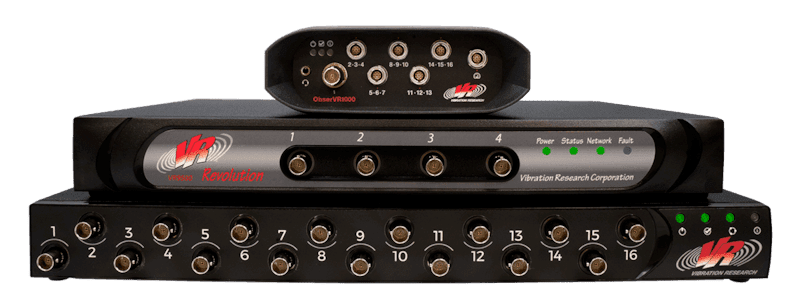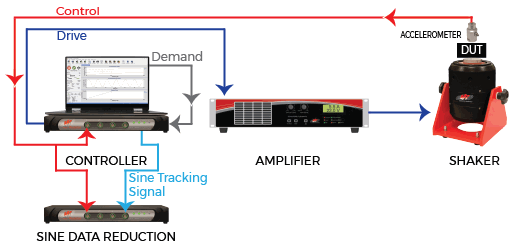Structural Dynamics Testing

Sine reduction (also called sine processing or sine data reduction) uses the COLA output of any VR controller to configure shaker control with a second instance of VibrationVIEW or a third-party product.
The main controller runs a sine sweep test, likely with user-defined tracking filters. The COLA signal tracks the drive frequency and instantly calculates the amplitude and phase at the frequency value. The VR I/O unit runs the same sine sweep using the COLA signal as the frequency reference, so the tracking filters are applied the same.
Accurate frequency tracking ensures the identification of resonant frequencies for product development and qualification.

Reporting
The VibrationVIEW software displays the sine sweep results for independent verification of the test results. Generate reports with graphs such as:
- Total harmonic distortion (THD): measures how accurately a vibration system is reproducing the output signal from a controller.
- Transmissibility: uncovers a resonance or anti-resonance in a system.
- Transfer function: determines the phase relationships between two signals.
Sine Sweep
Run sequences of fixed-frequency sinusoids of a specified acceleration, velocity, or displacement. Test duration options include the length of time, number of sine wave cycles, or number of sweeps.
Additional Features
- Specify linear or logarithmic sweeps
- Change the sweep type while the test is running
- Easily repeat tone sequences with the looping function
- Set individual sweep rates and tolerances by segment
Sine Software
Critical Safety
Many test items in aerospace and other industries are of high value, and close monitoring during testing is crucial. Technicians can configure abort limits for all channels or individual ones.
Additional Safety Options
- Emergency stop (e-stop) button: stop a test without inputting a transient shock (add-on option for the VR10500)
- Drive limits: prevent overdriving the shaker in case of failed accelerometers
- Adaptive feedback: allows for tighter control outside a resonance while ensuring stability at sharp resonances
Force Limiting
Vibration force limiting prevents over-testing due to large base reaction forces or other responses at a structure’s fixed-base resonant frequencies.
In VibrationVIEW’s Sine test mode, you can apply a force limit to one or multiple axes during a sine sweep.
High-channel-count Control
The VR10500 is Vibration Research’s high channel count control hardware for vibration and shock testing. Scalable to 512 channels and compatible with all electrodynamic and servo-hydraulic shakers. Features include up to 256kHz sample rate and 4 outputs for multi-shaker testing.




